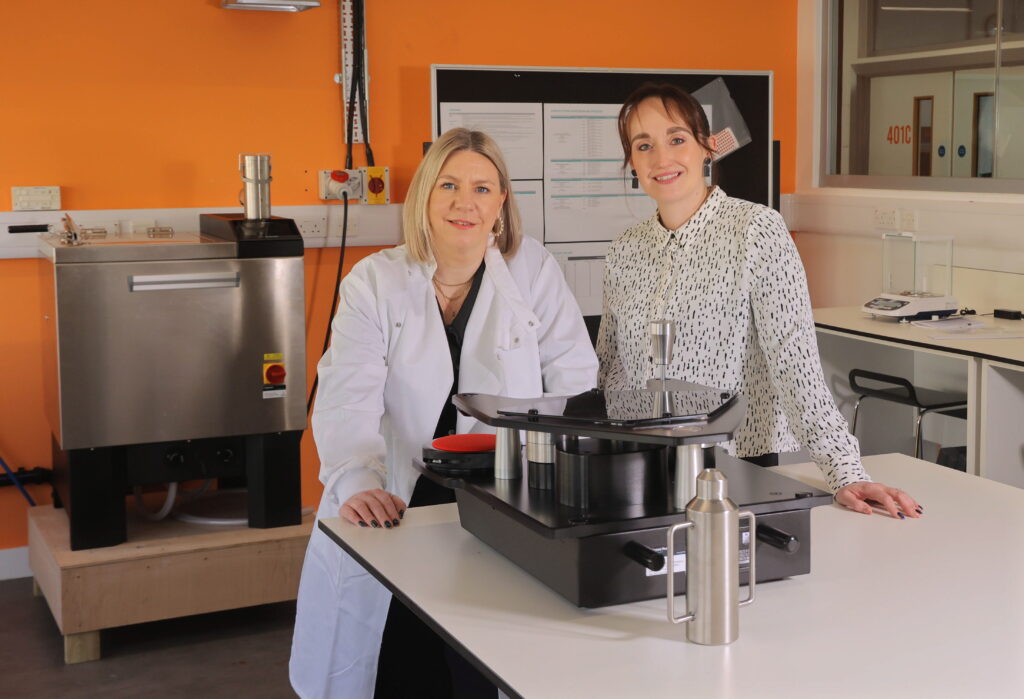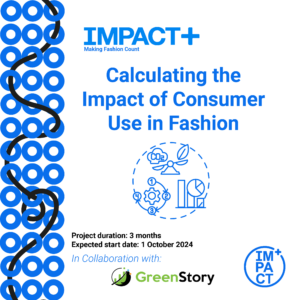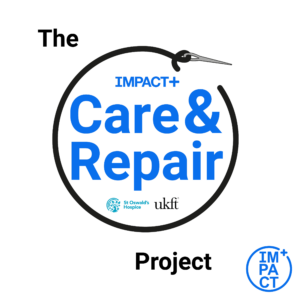NEWS
Latest News
The FibER Hub
We’re excited to announce our latest collaboration:
The Fibre-fragmentation and Environment Research (FibER) Hub
The FibER Hub, in partnership between Northumbria University and The Microfibre Consortium (TMC), is a newly established research hub which explores the full extent and environmental impact of microfibre loss from textiles.
It further develops work currently being pioneered by The Microfibre Consortium (TMC), a science-led nonprofit organisation which is convening the global textiles sector. Together, with the extensive expertise of the IMPACT+ team in microfibres as pollutants across land, water and air, the collaboration aims to bridge disciplinary knowledge between environmental science, forensic science and design.
Based in the Northumbria School of Design, The FibER Hub features state-of-the-art equipment which allows researchers to understand exactly what and how much fibre a fabric sheds at each stage of its lifespan. To date, the partnership has conducted a feasibility study into the quantification of microfibre loss in air, simulating shedding during the use and wear of clothing. Going forward, it will host extensive testing of a wide variety of fabrics to determine the level of microfibre loss under different conditions and the associated environmental impacts.

“This strategic partnership reflects the core aim of the IMPACT+ Network by focusing on microfibres as an overlooked and unmeasured environmental pollutant. Interdisciplinary collaboration with design and environmental science will enable our research to reduce fibre shedding at the root cause, whilst implementing these insights directly within an industry setting”. Alana James – Principal Investigator (IMPACT+)
“Through this collaboration, the TMC research team will provide direction to relevant research informed by industry needs, to go beyond what is possible today and create robust, wide ranging and comprehensive lifespan data on fibre fragmentation”. – Kelly Sheridan – CEO (The Microfibre Consortium)
It is hoped that this research will inform the development of more sustainable textiles in the future, with targeted interventions throughout the lifespan to reduce shedding rates and consequential environmental impact.
Sustainability Journal – Special Issue
Sustainability in Fashion and Textiles: Can Environmental Impact Assessments Inform a Circular Fashion Future?
This issue aims to address challenges regarding how environmental impact is measured and assessed across all phases of the fashion and textile product lifecycle from a multi-disciplinary perspective.
It encourages critical evaluation of the reliability, authenticity, and usability of data across atmospheric, terrestrial, and aquatic environments.
Exploring how existing methods of quantification could be having a detrimental effect on sustainable development across the sector, it aims to critically analyse existing tools, methods, and metrics to improve environmental impact assessment methodologies.

We invite researchers, industry experts, and academics to submit papers that address key areas such as:
- Environmental Impact Assessment (EIA) and Lifecycle Analysis (LCA): Addressing the short-comings of existing metrics and methodologies.
- Transparent Pathways to Environmental Impact Assessment (EIA): Enabling inclusive and accessible routes to accurate, reliable, and authentic sources of EIA.
- Circular Knowledge Systems: Forging cross-disciplinary collaborations and enabling evidenced-based scientific data to be utilised in the development of new products, processes and behaviours.
- Equitable Partnerships: Bridging and managing perceived knowledge/action gaps through communication efficiency across stakeholder groups.
Special Issue Editors Include:
Prof. Dr. Anne Peirson-Smith – School of Design, Northumbria University
Dr. Alana James – School of Design, Northumbria University
Dr. Kelly Sheridan – School of Applied Sciences, Northumbria University
Dr. Thomas Stanton – Department of Geography and Environment, Loughborough University
We welcome applications from all disciplines.
The deadline for manuscript submissions is the 31st October 2025.
For more information and submission guidelines, visit Sustainability Special Issue.
Green Story Collaboration
Impact of usage behaviour on lifecycle footprint of fashion products

IMPACT+ partners with Green Story to Revolutionize Clothing Usage and End-of-Life Data in the UK.
We are leading a groundbreaking project to explore the usage and end-of-life phase of clothing in the UK.
The initiative aims to collect crucial data on usage and end-of-life scenarios for ten key product categories, aligned with Product Category Rules (PCRs) for Environmental Product Declarations (EPDs) and Product Environmental Footprints (PEFs).
The goal is to provide brands and policymakers with actionable insights into the lifecycle of clothing, supporting the development of better systems and more sustainable products.
- Data Collection and Quality:
– Gather primary data on usage and end-of-life scenarios for 10 key clothing product categories.
– Ensure data accuracy and reliability.
- Life Cycle Assessments (LCAs):
– Develop cradle-to-grave LCAs for products from each of the categories.
– Use a “per wear” approach to build realistic and representative scenarios.
- Industry and Policy Impact:
– Generate actionable insights that can be used by brands and policymakers.
– Ensure that the findings are accessible and practical for stakeholders to implement.
- Adherence to Standards:
– Follow ISO 14040/44 standards for all LCA processes to maintain consistency.
– Align impact indicators to ensure comparability and relevance.
- Comprehensive Reporting
– Produce detailed reports that interpret the data and provide clear recommendations.
– Communicate results effectively to drive industry and policy changes towards more sustainable clothing lifecycles.
Collect data for usage and end of life for 10 key product categories aligning with PCRs for EPD/PEF.
Utilise data to create cradle to grave LCAs for representative products from these 10 categories. Preferably via an industry partner or selecting a theoretical representative product for each category.
LCAs will use the per wear approach to build scenarios.
- Finalisation of methodology and data sources.
- Lifecycle inventory based on primary data and secondary data.
- LCIA report with interpretation.
- Publications for broader reach.
The Care & Repair Project
The Care and Repair Guide: Reducing environmental impact and addressing skills gaps through responsible wardrobe management

The Care & Repair project aims to explore the critical relationship between consumers, brands and the charity retail sector regarding garment care, repair and second-life ownership to encourage responsible wardrobe management.
Collaborating with UKFT and St. Oswald’s Hospice, the project will empower stakeholders with foundational skills to facilitate sustainable clothing behaviours intended to extend the lifetime of clothing.
Key outputs will include a care and repair guide and workshops to activate critical intervention points. Upskilling tools will impart training opportunities about care and repair practices and responsible garment management within communities and domestic settings, including washing, repair and ownership behaviours.
- To analyse the relationship between consumer understanding of environmental impact and care practices
- To explore brand communication strategies regarding care and durability
- To empower consumers through repair skills in preventing damaged clothing being donated to the charity retail sector
- To enable the charity retail sector to divert damaged donations from rag and landfill through repair mechanisms
UK consumers wear a garment less than twice on average, with £30 billion of unused clothing residing in wardrobes, and an estimated £140 million worth of clothing annually ending up in landfill, with only 1% of clothing being recycled into new products, according to WRAP (WRAP, 2020). Of the 11.5 thousand UK charity shops between ten and 30 per cent of second-hand donations are resold in store, with many garments entering this waste stream or being diverted to landfill simply because they need repairing, typically because of stains, tears, pilling, broken seams and missing buttons. Care and repair will increasingly become a major requirement for brands, charities and consumers, yet current initiatives are uncoordinated or inaccessible for many stakeholders.
A co-ordinated response is needed to change how clothing is managed and consumed to extend the life of a garment and minimise waste. Reducing the rate at which the fashion industry is consuming resources is dependent on reducing the amount consumers purchase and extending garment longevity. This can be achieved through careful post-consumption clothing management, repair, renovation, renewal and upcycling.
The direct correlation between responsible garment care and resulting environmental impact of carbon emissions was found by a WRAP study to have been reduced in the UK by 700,000 tonnes from 2012-2016 because of minimising ironing, tumble drying and washing temperatures, for example (WRAP, 2021). The worn life of clothing can be significantly extended via repair with the Ellen MacArthur Foundation recently estimating that garment repairs can increase usage by 75% and reduce associated emissions by 30%.
Ensuring that reduced environmental impact in domestic aftercare settings occurs will require a collaborative approach between brands, NGOs and consumers. This will be achieved through a combination of knowledge and skills development and community engagement through a care & repair guide. The guide will be disseminated through brand-driven sessions and knowledge exchange workshops.
AKT Funded Project
Quantification of Microfibres in Air: a feasibility study

Microfibres as pollutants are an under-researched environmental impact caused by the fashion and textile industries.
Fibres are released through fragmentation in air, water and soil environments, with high levels of loss occurring during the manufacturing process and consumer use of textiles.
This project addresses key challenges facing sustainable manufacturing and design interventions for circularity. Data generated from testing using an industry-standard test method, will empower brands to be to choose fabrics which shed less, driving future innovative advancements in textile manufacturing.
The Microfibre Consortium (TMC) have pioneered an industry recognised test method for fibre loss quantification during washing, however, there remains a critical gap in the knowledge of MF loss in air. TMC have evidenced an industry need for the development of such and are working with their signatories to gather momentum across the industry for commercial application. The AKT funding will enable TMC to address a critical industry need whilst supporting the sector’s transition towards scalable circular solutions.
This project addresses key challenges facing sustainable manufacturing and design interventions for circularity. MF fragmentation contributes significantly as a barrier to the sector meeting circularity targets in 2050 and remains a critical need to drive innovative action and collaboration.
The key innovation generated by the AKT will be the development of an effective test method for the quantification of MF loss in air.
Data generated from testing using an industry-standard test method, will empower brands to choose fabrics which shed less, driving future innovative advancements in textile manufacturing.